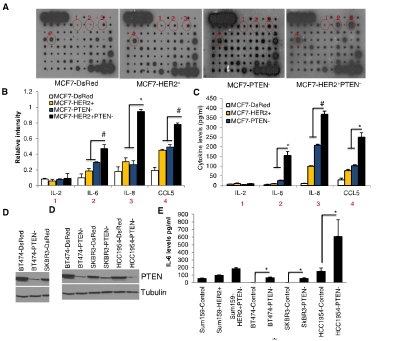Demonstrated in Neural Progenitor Cells
We have proven and effective tools for delivering
siRNA, shRNA and miRNA for gene expression analysis and
measuring apoptosis in vivo.
We are pleased to introduce a new application for one of our
neural progenitor markers. In this study our
Chicken Nestin Antibody is used to stain these progenitors in dissected mouse brains:
Gleave JA, Lerch JP, Henkelman RM, Nieman BJ (2013) A Method for 3D Immunostaining and Optical Imaging of the Mouse Brain Demonstrated in Neural Progenitor Cells. PLoS ONE 8(8): e72039. doi:10.1371/journal.pone.0072039.
3D antibody staining of adult mouse brains: 1% PFA perfused adult mouse brains were removed from the skull and then divided by removing the cerebellum and separating the hemispheres if desired. The samples were immediately dehydrated in a gradient of methanol solutions to 100% methanol over the course of one day. Immediate dehydration is important to preserve the cellular morphology of the lightly-fixed brain. The samples then underwent freeze/thaw (one hour at –80°C/one hour at room temperature) four times. The samples were rehydrated in a gradient of methanol solutions to PBS over the course of one day. The samples were mildly digested for 5 minutes using 10 mg/ml of Proteinase K (Promega, WI, USA) and then thoroughly washed to remove any residual Proteinase K. Antigen retrieval was performed using a Histos5 histology microwave (Milestone, MI, USA) in 0.01 M sodium citrate buffer pH 6 on an antigen retrieval program (0–90°C 11min, 90–98°C 3min, 98°C 10min). The samples were cooled to RT and subsequently washed in PBS to remove excess buffer. From this point, all incubations were performed in the Histos5 histology microwave. The samples were incubated at 37°C for 48 hours in primary antibody diluted in 5% normal goat serum (Jackson ImmunoResearch, PA, USA), 5% dimethylsulfoxide (DMSO, Fisher Scientific, Ontario, Canada), and 0.01% Triton X-100 (Bioshop Canada, Ontario, Canada). The samples were then washed at 37°C for 48 hours in 5% serum, 0.01% Triton X-100, replacing the solution once after 24 hours. Following this, the samples were incubated for 72 hours in secondary antibody diluted in 5% serum, 5% DMSO, and 0.01% Triton X-100. Finally, the samples were washed at 37°C for 48 hours in 0.01% Triton X-100, replacing the solution once after 24 hours.
Staining of single hemisphere brain samples using the described protocol for 3D imaging included the following: doublecortin (n = 4), GFAP (n = 4), nestin (n = 3), double stain of doublecortin and nestin (n = 1). Doublecortin was also used to stain a full mouse brain excluding the cerebellum (n = 2).
Control samples were generated using pre-absorbed primary antibodies when possible by incubating the primary antibody with a blocking peptide for 30 minutes at room temperature prior to staining. If no peptide for the primary antibody was available, the staining procedure was performed in the control except that the primary antibody was omitted during the appropriate step.
Staining was performed with the following antibodies: rabbit anti-doublecortin (Abcam), goat anti-doublecortin and peptide (Santa Cruz Biotechnology) rabbit anti-GFAP (Dako),
chicken anti-nestin (Neuromics), goat anti-rabbit alexafluor 546 (Invitrogen), goat anti-rabbit alexafluor 488 (Invitrogen), goat anti-rabbit alexafluor 647 (Invitrogen), goat anti-chicken alexafluor 546 (Invitrogen), goat anti-chicken alexafluor 488 (Invitrogen), donkey anti-goat alexafluor 546 (Invitrogen), donkey anti-goat alexafluor 488 (Invitrogen).

Images: Validation of 3D nestin staining. Cryosections cut from a stained brain hemisphere show nestin-positive cells (red; arrows, A). Some additional punctate fluorescence was present (arrowheads, A). The sections were re-probed with a secondary antibody (green; A) to highlight primary antibody left unbound by secondary antibody. No evidence of primary antibody left unbound by secondary antibody was found. Sections were also re-stained with both primary and secondary antibodies (B) to highlight primary-antibody antigen sites unoccupied. There is overlap of the original 3D nestin stain with the 2D re-stain (arrowheads). LV = Lateral ventricle, scalebars = 100 µm. doi:10.1371/journal.pone.0072039.g003
The best news of all: This staining method is simple, using a combination of heat, time and specimen preparation procedures readily available, so that it can be easily implemented without the need for specialized equipment, making it accessible to most laboratories.






























